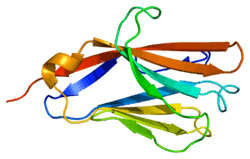CD300LF
CMRF35-like molecule 1 is a protein that in humans is encoded by the CD300LF gene.[3][4]
CD300LF is an inhibitory receptor of the Ig superfamily expressed on myeloid cells. It mediates negative regulatory signals by recruiting SHP1 (PTPN6; MIM 176883) or SHIP (INPP5D; MIM 601582) (Sui et al., 2004; Alvarez-Errico et al., 2004).[supplied by OMIM][4]
References
- ↑ "Human PubMed Reference:".
- ↑ "Mouse PubMed Reference:".
- ↑ Clark HF, Gurney AL, Abaya E, Baker K, Baldwin D, Brush J, Chen J, Chow B, Chui C, Crowley C, Currell B, Deuel B, Dowd P, Eaton D, Foster J, Grimaldi C, Gu Q, Hass PE, Heldens S, Huang A, Kim HS, Klimowski L, Jin Y, Johnson S, Lee J, Lewis L, Liao D, Mark M, Robbie E, Sanchez C, Schoenfeld J, Seshagiri S, Simmons L, Singh J, Smith V, Stinson J, Vagts A, Vandlen R, Watanabe C, Wieand D, Woods K, Xie MH, Yansura D, Yi S, Yu G, Yuan J, Zhang M, Zhang Z, Goddard A, Wood WI, Godowski P, Gray A (Oct 2003). "The secreted protein discovery initiative (SPDI), a large-scale effort to identify novel human secreted and transmembrane proteins: a bioinformatics assessment". Genome Res. 13 (10): 2265–70. doi:10.1101/gr.1293003. PMC 403697
 . PMID 12975309.
. PMID 12975309. - 1 2 "Entrez Gene: CD300LF CD300 molecule-like family member f".
Further reading
- Strausberg RL, Feingold EA, Grouse LH, et al. (2003). "Generation and initial analysis of more than 15,000 full-length human and mouse cDNA sequences". Proc. Natl. Acad. Sci. U.S.A. 99 (26): 16899–903. doi:10.1073/pnas.242603899. PMC 139241
 . PMID 12477932.
. PMID 12477932.
- Chung DH, Humphrey MB, Nakamura MC, et al. (2004). "CMRF-35-like molecule-1, a novel mouse myeloid receptor, can inhibit osteoclast formation". J. Immunol. 171 (12): 6541–8. doi:10.4049/jimmunol.171.12.6541. PMID 14662855.
- Ota T, Suzuki Y, Nishikawa T, et al. (2004). "Complete sequencing and characterization of 21,243 full-length human cDNAs". Nat. Genet. 36 (1): 40–5. doi:10.1038/ng1285. PMID 14702039.
- Sui L, Li N, Liu Q, et al. (2004). "IgSF13, a novel human inhibitory receptor of the immunoglobulin superfamily, is preferentially expressed in dendritic cells and monocytes". Biochem. Biophys. Res. Commun. 319 (3): 920–8. doi:10.1016/j.bbrc.2004.05.065. PMID 15184070.
- Zhang Z, Henzel WJ (2005). "Signal peptide prediction based on analysis of experimentally verified cleavage sites". Protein Sci. 13 (10): 2819–24. doi:10.1110/ps.04682504. PMC 2286551
 . PMID 15340161.
. PMID 15340161.
- Gerhard DS, Wagner L, Feingold EA, et al. (2004). "The status, quality, and expansion of the NIH full-length cDNA project: the Mammalian Gene Collection (MGC)". Genome Res. 14 (10B): 2121–7. doi:10.1101/gr.2596504. PMC 528928
 . PMID 15489334.
. PMID 15489334.
- Alvarez-Errico D, Aguilar H, Kitzig F, et al. (2005). "IREM-1 is a novel inhibitory receptor expressed by myeloid cells". Eur. J. Immunol. 34 (12): 3690–701. doi:10.1002/eji.200425433. PMID 15549731.
- Alvarez-Errico D, Sayós J, López-Botet M (2007). "The IREM-1 (CD300f) inhibitory receptor associates with the p85alpha subunit of phosphoinositide 3-kinase". J. Immunol. 178 (2): 808–16. doi:10.4049/jimmunol.178.2.808. PMID 17202342.
PDB gallery |
|---|
|
| 2nms: The Crystal Structure of the Extracellular Domain of the Inhibitor Receptor Expressed on Myeloid Cells IREM-1 |
|
|

 . PMID 12975309.
. PMID 12975309. . PMID 12477932.
. PMID 12477932. . PMID 15340161.
. PMID 15340161. . PMID 15489334.
. PMID 15489334.